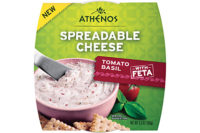Cheese purists might blanch at the thought of cotton candy-flavored cheese, but children love it, says the Center for Dairy Research at the University of Wisconsin-Madison. Research scientists at the Center have also cooked up green apple, banana, berry, bubblegum and chocolate flavors. If you don’t see your favorite flavor on the menu, just ask. The Center is more than happy to make it for you.
At last week’s International Cheese Technology Expo in Milwaukee, the Center served samples of the flavored processed cheeses in the hope that a dairy processor will license the technology. A fact sheet notes that “the potential for U.S. growth in this area is huge as these products have proven to be extremely popular in other parts of the world.”
Despite the candy-like flavors, the cheese is nutritious, delivering 16% to 18% protein as well as several key minerals such as calcium and phosphorus.
The fact sheet describes how the cheese is made. “Essentially, cheese curd is placed into a processed cheese cooker and heated to a high temperature typically used in processed cheese. These high temperatures kill starter cultures and destroy enzymes which help to extend the flavor and texture as well as shelf life of the retail product up to six months. During the manufacturing process, natural flavors, colors, and sweeteners are added to enhance the visual and flavor attributes of the cheese.”
The flavored-cheese project is just one of many that the Center hopes to commercialize. CDR received a $1 million i6 challenge grant for the federal government which it is using to speed the transfer of technology from academia to the private sector. The so-called Turbo program (Tech Transfer, University Research and Business Opportunity) program is a business accelerator initiative that will support the commercialization of novel dairy technologies and products.
Other projects the Center wants to license to food and beverage processors include:
- A patented process that improves the emulsifying ability, heat stability and acid stability of dairy proteins. This technique offers manufacturers the opportunity to use proteins in applications where it was previously impossible due to heat and acid conditions.
- Development of a superior whey protein concentrate (a.k.a. native whey). For processors interested in manufacturing MD-WPC, a polymeric spiral wound microfiltration system will be necessary. CDR can offer manufacturing trials in its processing pilot plant on the UW-Madison campus.
- Development of a less costly, domestically produced, caseinate alternative (water soluble casein). Researchers at CDR have developed a method to produce a modified MPC that can act as a caseinate alternative. The MPC is modified to contain more soluble caseins and have a lower mineral content. Essentially, the technology uses a gentle acidification process to acidify the milk, which is then washed (diafiltered) before microfiltration is used to reduce unwanted minerals/lactose.
For more information about these projects and others, contact Vic Grassman, technology commercialization manager, at 608-512-6661.



